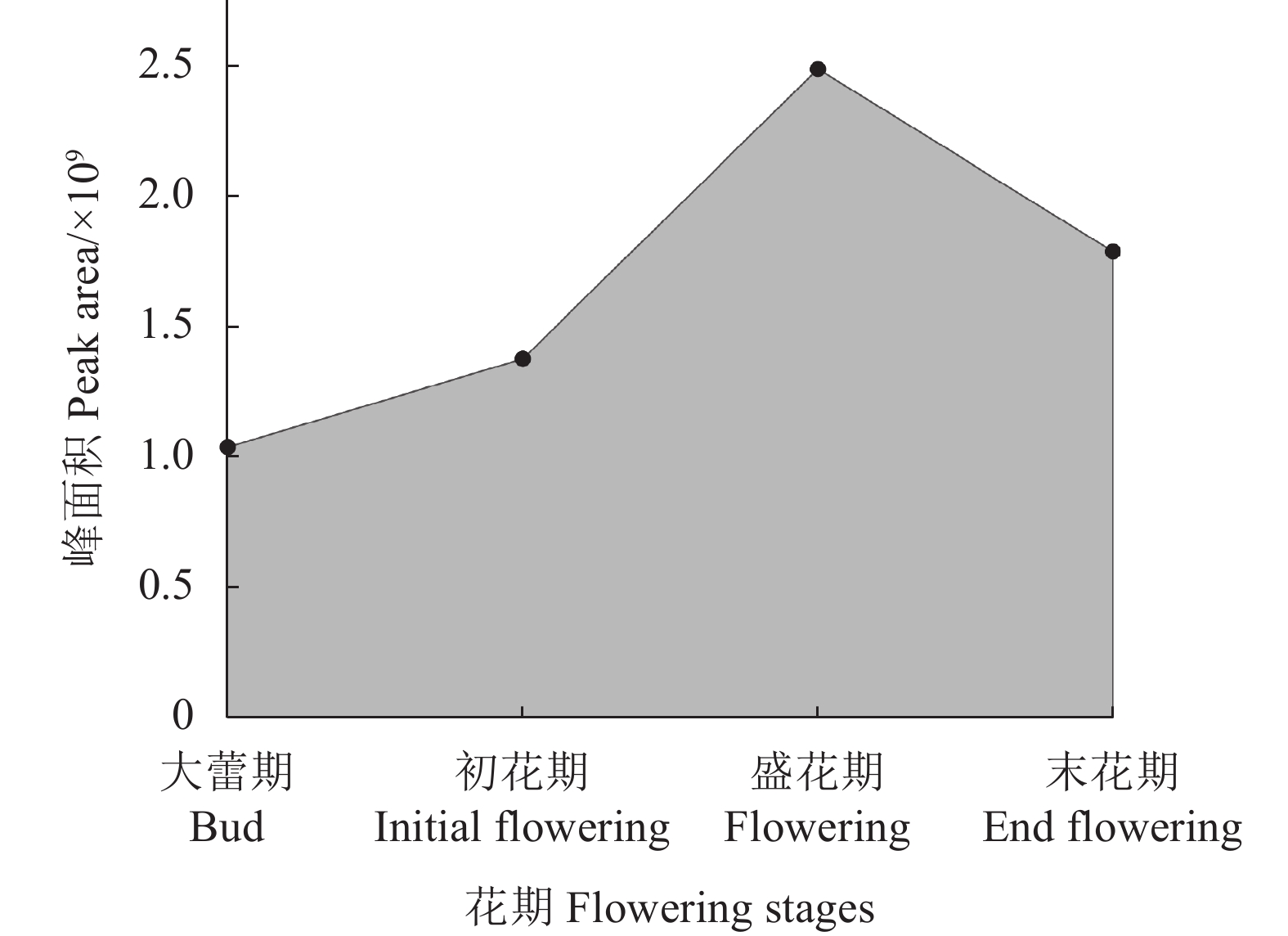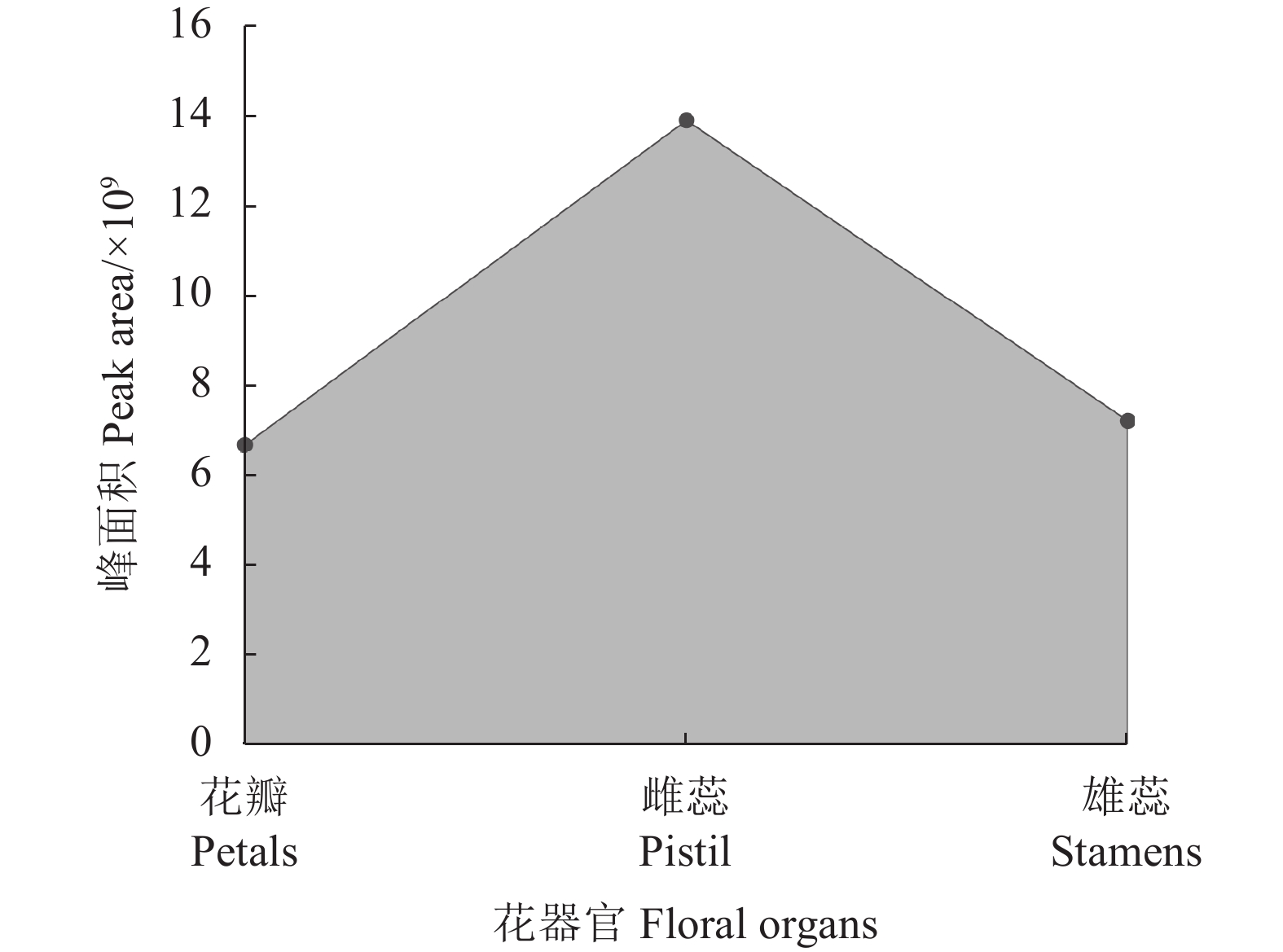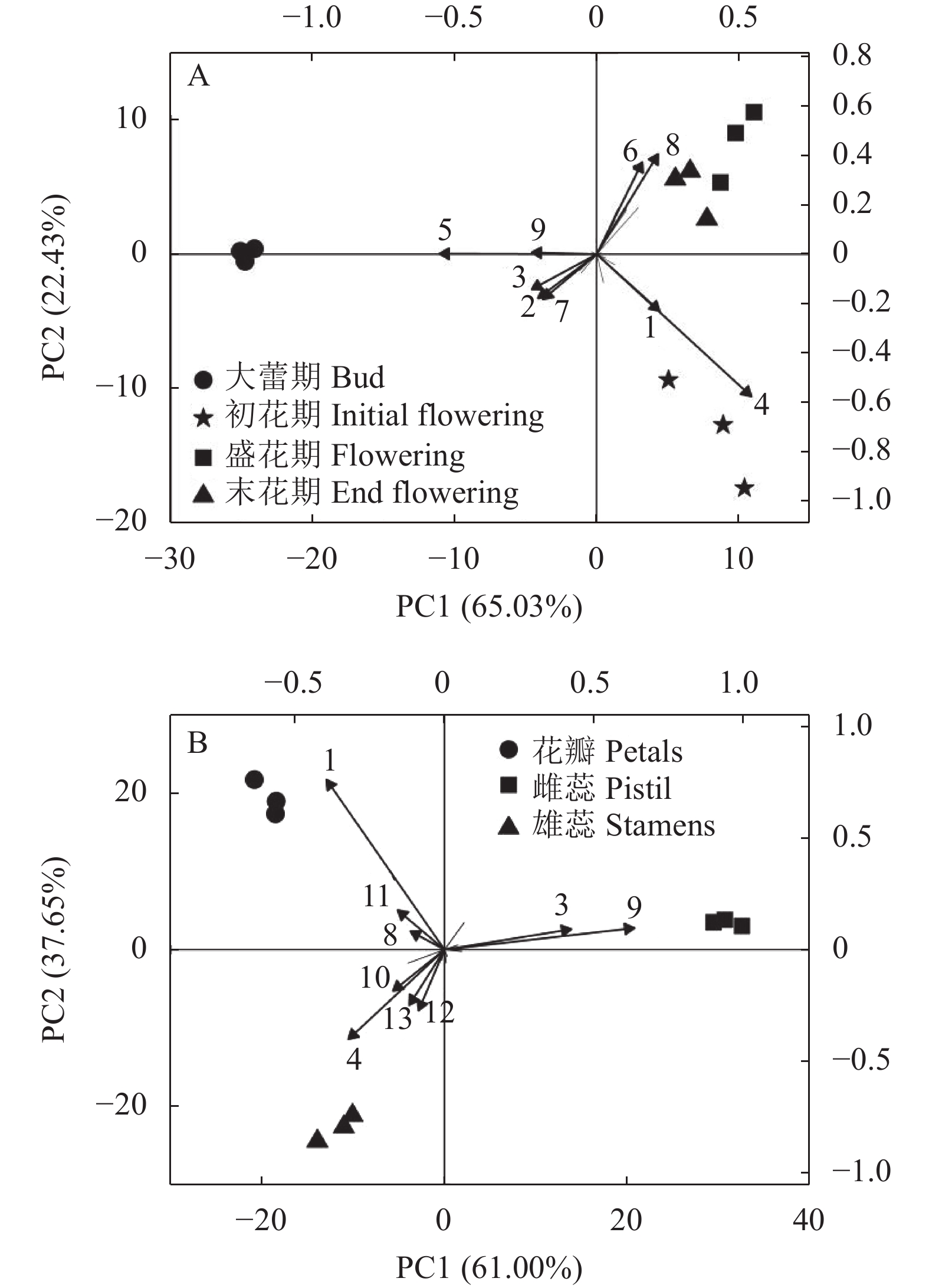Aromatics in Floral Organs of Malus Brandywine during Different Flowering Stages
-
摘要:
目的 探索‘白兰地’海棠(M. 'Brandywine')花香成分释放规律,为海棠芳香花育种和花香调控奠定基础。 方法 以香气浓郁的‘白兰地’海棠花朵鲜样为试材,采用固相微萃取与气质联用技术(SPME-GC-MS)分析不同花期和不同花器官的香气成分差异。 结果 (1)从大蕾期到盛花期分别检测出23、30、30、32种挥发性成分,其中叶醇、芳樟醇、己酸甲酯、乙酸叶醇酯、甲基庚烯酮和α-法呢烯为‘白兰地’海棠主要挥发性成分。花香总释放量呈现先上升后下降的趋势,在盛花期达到最高。香气成分种类构成主要以萜烯类(14.47 %~37.30 %)和醛酮类(21.64 %~38.78 %)为主,相对含量分别在盛花期和大蕾期达到最高,萜烯类相对含量在花朵开放过程中先上升后下降,而烷烃类和酯类呈现先下降后上升的趋势。对不同时期与挥发性成分之间进行了主成分分析,累计方差贡献率达 87.64 %,芳樟醇和壬醛分别在PC1正、负方向上贡献最大,分别与大蕾期和初花期呈高度正相关。(2)盛花期花朵花瓣、雌蕊(含花萼)和雄蕊中分别检测出28、32、25种挥发性成分。雌蕊总释放量最高,花瓣最低,对不同花器官与挥发性成分之间进行了主成分分析,累计方差贡献率达98.65 %。己酸甲酯、芳樟醇和α-法呢烯在PC1和PC2上的贡献较高,分别是花瓣、雄蕊和雌蕊的主要香气成分。3种花器官均位于不同象限,不同花器官的花香成分存在明显差异。 结论 叶醇、芳樟醇、己酸甲酯、乙酸叶醇酯、甲基庚烯酮和α-法呢烯为‘白兰地’海棠主要挥发性成分,盛花期香气成分种类构成主要以萜烯类为主,不同花器官的花香成分存在明显差异,挥发性成分释放的主要花器官是雌蕊。 Abstract:Objective Release of aromatics from floral organs of Malus Brandywine was studied for new variety breeding. Method Freshly picked floral organ samples of the strongly fragrant Malus Brandywine in different flowering stages were analyzed for aromatic components by SPME-GC-MS. Result (1) There were 23, 30, 30, and 32 volatiles detected in the floral organs from budding to full bloom stage. They included predominantly (Z)-3-hexen-1-ol, linalool, hexanoic acid-methyl ester, (Z)-3-hexen-1-ol, and 6-methyl-5-hepten-2-one, and α-farnesene. The total fragrance release was in an increasing trend initially to peak at the full bloom stage before decline toward the end. The released aromatics consisted largely of terpenes (14.47-37.30%) and aldehydes and ketones (21.64-38.78 %) with the highest relative contents of terpenes at full bloom, while aldehydes and ketones when large buds appeared. The terpenoids increased at opening of the flowers followed by a decline, while alkanes and esters decreased at first but rose later. A principal component analysis on the volatiles at different flowering stages showed a cumulative variance contribution of 87.64%. On PC1, linalool contributed the most and significantly correlated positively in the large bud stage, whereas nonanal the most and significantly correlated negatively in the initial flowering stage. (2) At full blooming, 28, 32, and 25 volatiles were detected in the petals, pistil (including calyx), and stamens, respectively. The greatest fragrance release in quantity came from the pistil and the least from the petals. A principal component analysis on the compounds in different organs yielded a cumulative variance contribution of 98.65 %. On PC1 and PC2, hexanoic acid-methyl ester, linalool, and α-farnesene contributed more and were the major aromatics in the petals, stamens, and pistils, respectively. The 3 floral organs were in different quadrants and significantly differed in the composition of the aromatics they released. Conclusion (Z)-3-hexen-1-ol, linalool, hexanoic acid-methyl ester, (Z)-3-hexen-1-ol, 6-methyl-5-hepten-2-one, and α-Farnesene were the major volatiles in floral organs of Malus Brandywine. Terpenes were the dominant aromatics released during the full bloom stage. Significantly differences in the aromatic composition of the fragrance discharged from different floral organs. The releases of these volatiles took place mainly in the pistil. -
Key words:
- Malus /
- flowering period /
- floral organs /
- volatile components /
- floral fragrance release pattern
-
图 5 挥发性成分的主成分分析
①A:花期;B:花器官。②图中数字1:己酸甲酯;2:甲基庚烯酮;3:乙酸叶醇酯;4:芳樟醇;5:壬醛;6:(E)-4,8-二甲基-1,3,7-壬三烯;7:正十二烷;8:2-十三烷酮;9:α-法呢烯;10:4-辛烯酸甲酯;11:辛酸甲酯;12:苯乙醇;13:4-亚甲基异佛尔酮。
Figure 5. Principal component analysis based on volatiles
①A: flowering stages; B: floral organs. ②1: Hexanoic acid-methyl ester; 2: 6-methyl-5-hepten-2-one; 3: (Z)-3-hexen-1-ol, acetate,; 4: linalool; 5: nonanal; 6: (E)-4,8-dimethylnona-1,3,7-triene; 7: dodecane; 8: 2-tridecanone; 9: α-farnesene; 10: 4-octenoic acid, methyl ester; 11: octanoic acid, methyl ester; 12: phenylethyl alcohol; 13: 4-methyleneisophorone.
表 1 ‘白兰地’海棠不同花期的挥发性成分鉴定
Table 1. Identification of volatiles in different flowering stages of Malus Brandywine
化合物
Compound保留时间
Retention time/s相对含量 Relative content/% 大蕾期
Bud初花期
Initial flowering盛花期
Flowering末花期
End flowering萜烯类 Terpenes 芳樟醇 Linalool 9.92 — 25.19±5.27 a 14.75±0.63 b 13.05±1.99 b 壬醛 Nonanal 9.96 18.48±0.25 — — — (E)-4,8-二甲基-1,3,7-壬三烯 (E)-4,8-Dimethylnona-1,3,7-triene 10.17 — — 9.74±2.54 a 5.71±0.59 b β-紫罗兰酮 3-Buten-2-one,4-(2,6,6-trimethyl-1-cyclohexen-1-yl)- 15.54 — — 0.71±0.25 b 2.42±0.63 a 香叶基丙酮 5,9-Undecadien-2-one, 6,10-dimethyl- 17.68 — 1.12±0.09 b 4.70±0.33 a 4.83±0.33 a 二氢-Β-紫罗兰酮 2-Butanone,4-(2,6,6-trimethyl-1-cyclohexen-1-yl)- 17.92 — 0.05±0.01 b 0.36±0.16 b 2.46±0.85 a α-法呢烯 à-Farnesene 19.55 14.47±4.67 a 6.94±2.44 b 7.04±3.26 b 7.28±1.39 b 酯类 Esters 己酸甲酯 Hexanoic acid, methyl ester 6.57 1.26±1.51 c 11.67±1.24 a 7.12±2.85 b 7.31±0.82 b 乙酸叶醇酯 3-Hexen-1-ol, acetate, (Z)- 8.01 9.37±2.77 a 3.93±0.74 b 0.82±0.04 c 0.70±0.61 c 5-庚烯酸甲酯 5-Heptenoic acid, methyl ester 8.29 — — — 0.01±0.01 2-乙基己酸甲酯 Hexanoic acid, 2-ethyl-, methyl ester 8.62 — — 0.42±0.20 a 0.34±0.12 b 丙酸芳樟酯 1,6-Octadien-3-ol, 3,7-dimethyl-, propanoate 8.82 1.30±0.12 — — — 4-辛烯酸甲酯 4-Octenoic acid, methyl ester 10.19 — 2.54±0.29 — — 辛酸甲酯 Octanoic acid, methyl ester 10.37 0.32±0.12 b 2.98±0.46 a 2.00±0.73 a 2.49±0.35 a 异戊酸香叶酯 Geranyl isovalerate 10.85 0.34±0.14 a 0.06±0.01 b — — 顺-3-己烯基丁酸酯 Butanoic acid, 3-hexenyl ester, (Z)- 11.72 — 1.17±0.31 a 0.38±0.03 b 0.75±0.24 b (10E)-10-十七烯-8-炔酸甲酯 10-Heptadecen-8-ynoic acid, methyl ester, (E)- 12.59 — — — 0.20±0.15 顺式-3-己烯醇 2-甲基丁酸酯 cis-3-Hexenyl-à-methylbutyrate 12.86 2.36±0.47 a 1.66±0.16 b — — 3-甲基-2-丁烯酸-2-苯乙酯 2-Butenoic acid, 3-methyl-, 2-phenylethyl ester 15.04 — — — 1.14±0.44 (Z,Z)-3-己烯基2-甲基-2-丁烯酸酯 (Z)-(Z)-Hex-3-en-1-yl 2-methylbut-2-enoate 15.09 — 0.87±0.14 — — 顺式-3-己烯醇苯甲酸酯 3-Hexen-1-ol, benzoate, (Z)- 21.83 — — 0.08±0.07 — 肉豆蔻酸甲酯 Methyl tetradecanoate 25.90 — — 0.11±0.04 a 0.16±0.06 a 醇类 Alcohols 叶醇 3-Hexen-1-ol, (Z)- 5.82 9.00±0.50 a 7.71±1.25 ab 5.57±1.18 ab 4.40±0.45 b 3-甲基-4-戊醇 4-Penten-1-ol, 3-methyl- 6.22 — 0.12±0.04 a 0.04±0.01 ab 0.11±0.05 a 苯乙醇 Phenylethyl Alcohol 10.51 — — 2.35±0.73 b 4.82±0.61 4-甲氧基苯乙醇 2-(4-Methoxyphenyl)ethanol 17.07 — — 0.25±0.10 a 0.19±0.06 a 醛酮类 Aldehydes and ketones 4-羟基查耳酮 4-Hydroxychalcone 5.20 1.35±0.23 a 0.44±0.09 ab 0.56±0.19 ab 1.18±1.00 a 甲基庚烯酮 5-Hepten-2-one, 6-methyl- 7.67 14.98±1.29 a 10.39±2.10 b 6.49±0.49 c 7.56±0.12 c 4-氧代异佛尔酮 2,6,6-Trimethyl-2-cyclohexene-1,4-dione 10.95 — 1.76±0.16 a 2.01±1.10 a — 2,2,6-三甲基-1,4-环己二酮 1,4-Cyclohexanedione,2,2,6-trimethyl- 11.51 — 0.57±0.22 ab 0.90±0.14 a — 癸醛 Decanal 12.25 2.93±0.58 a 1.83±0.29 b — 1.06±0.07 c 4-亚甲基异佛尔酮 4-Methyleneisophorone 12.78 1.04±0.18 d 3.28±0.95 c 6.51±0.83 b 8.56±0.30 a 2-十三烷酮 2-Tridecanone 19.24 — 2.15±0.89 bc 11.44±5.66 a 7.00±2.12 ab 2-十五烷酮 2-Pentadecanone 25.34 — 1.22±0.61 bc 5.67±2.24 a 3.17±1.10 a 烷烃类 Alkanes 癸烷 Decane 7.87 0.14±0.01 a 0.11±0.00 a — — 正十一烷 Undecane 9.78 2.11±0.41 a 1.25±0.32 b — — 3-甲基十一烷 Undecane, 3-methyl- 11.33 1.97±0.24 — — — 正十二烷 Dodecane 11.99 10.46±1.50 a 6.60±0.64 2.31±0.39 c 3.76±0.53 c 正十三烷 Tridecane 14.35 1.11±0.30 a 0.87±0.14 a 1.18±0.03 a 1.20±0.12 a 7-甲基十七烷 Heptadecane, 7-methyl- 15.20 0.54±0.03 a 0.40±0.04 a — — 9-甲基十九烷 Nonadecane, 9-methyl- 15.30 — 0.15±0.05 — — 10-甲基二十烷 Eicosane, 10-methyl- 15.49 0.35±0.06 — — — 3-甲基十三烷 Tridecane, 3-methyl- 16.05 2.19±0.31 a 1.29±0.24 b 0.52±0.03 c — 3-亚甲基十三烷 Tridecane, 3-methylene- 16.43 1.15±0.05 — — — 正十四烷 Tetradecane 16.76 2.79±0.44 b 1.76±0.20 c 2.51±0.28 b 4.14±0.35 a 正十六烷 Hexadecane 22.40 — — — 0.36±0.03 正二十一烷 Heneicosane 28.45 — — — 0.82±0.49 酚类 Phenols 对甲苯甲醚 Benzene, 1-methoxy-4-methyl- 8.43 — — 3.36±1.78 a 1.69±0.68 b 甲基苯乙基醚 Benzene, (2-methoxyethyl)- 9.61 — — — 1.12±0.07 2,6-二叔丁基对甲酚 Butylated Hydroxytoluene 19.82 — — 0.09±0.03 — “—”表示该数据未被检索到或者未被检测出;同一行中不同的小写字母表示在 0.05 水平上差异显著 。表2同。
"—" indicates that the data have not been reported by other studies or the compound has not been detected. Different lowercases in the same line indicate the significant difference at 0.05 level.The same as table 2.表 2 ‘白兰地’海棠不同花器官的挥发性成分鉴定
Table 2. Identification of Malus Brandywine volatiles in floral organs
化合物
Compound保留时间
Retention time/s相对含量 Relative content/% 花瓣
Petals雌蕊
Pistil雄蕊
Stamens萜烯类 Terpenes 芳樟醇 Linalool 9.92 10.01±2.00 b — 23.59±4.01 a (E)-4,8-二甲基-1,3,7-壬三烯 (E)-4,8-Dimethylnona-1,3,7-triene 10.15 — 6.03±0.60 — β-紫罗兰酮 3-Buten-2-one, 4-(2,6,6-trimethyl-1-cyclohexen-1-yl)- 15.53 — 1.81±0.34 — 香叶基丙酮 5,9-Undecadien-2-one, 6,10-dimethyl- 17.66 2.29±0.59 b 2.63±0.01 ab 3.85±0.72 a 二氢-Β-紫罗兰酮 2-Butanone, 4-(2,6,6-trimethyl-1-cyclohexen-1-yl)- 17.90 — 3.05±0.48 a 0.91±0.28 b α-法呢烯 à-Farnesene 19.55 3.33±1.14 b 34.12±2.90 a 3.74±2.57 b 酯类 Esters 己酸甲酯 Hexanoic acid, methyl ester 6.54 35.41±2.72 a 2.87±0.67 b — 乙酸叶醇酯 3-Hexen-1-ol, acetate, (Z)- 7.98 0.59±0.18 b 20.47±0.39 a — 5-庚烯酸甲酯 5-Heptenoic acid, methyl ester 8.25 — 0.03±0.01 — 庚酸甲酯 Heptanoic acid, methyl ester 8.29 1.11±0.38 a — 0.40±0.37 b 2-乙基己酸甲酯 Hexanoic acid, 2-ethyl-, methyl ester 8.62 0.17±0.01 — — 4-辛烯酸甲酯 4-Octenoic acid, methyl ester 10.17 5.91±1.06 b — 12.33±1.70 a 辛酸甲酯 Octanoic acid, methyl ester 10.32 13.60±5.33 a 2.60±0.12 b 4.89±0.06 aab 3-丁酸己烯酯 Butanoic acid, 3-hexenyl ester, (E)- 10.71 — 0.91±0.09 — 顺-3-己烯基丁酸酯 Butanoic acid, 3-hexenyl ester, (Z)- 11.68 — 4.99±0.55 — 2-甲基丁酸己酯 Butanoic acid, 2-methyl-, hexyl ester 12.84 — 3.00±0.49 a 0.53±0.03 b 己酸异戊酯 Isopentyl hexanoate 13.16 — — 0.20±0.05 3-壬酸甲酯 3-Nonenoic acid, methyl ester 14.60 — 0.26±0.01 — (Z,Z)-3-己烯基2-甲基-2-丁烯酸酯 (Z)-(Z)-Hex-3-en-1-yl 2-methylbut-2-enoate 15.01 — 2.39±0.00 — 己酸叶醇酯 Hexanoic acid, 3-hexenyl ester, (Z)- 16.35 0.51±0.09 b 2.44±0.05 a — 己酸己酯 Hexanoic acid, hexyl ester 16.44 0.25±0.02 b 0.85±0.04 a — 顺式-3-己烯醇苯甲酸酯 3-Hexen-1-ol, benzoate, (Z)- 21.81 — 0.45±0.06 a 0.22±0.02 a 肉豆蔻酸甲酯 Methyl tetradecanoate 25.90 0.31±0.15 — — 醇类 Alcohols 叶醇 3-Hexen-1-ol, (Z)- 5.78 4.45±0.90 a 5.84±1.31 a — 3-甲基-1,5-戊二醇 1,5-Pentanediol, 3-methyl- 5.93 — 0.04±0.00 — 6-甲基-5-庚烯-2-醇 5-Hepten-2-ol, 6-methyl- 7.78 — 0.84±0.16 a 1.15±1.62 a 苯乙醇 Phenylethyl Alcohol 10.48 — — 11.04±1.59 醛酮类 Aldehydes and ketones 4-羟基查耳酮 4-Hydroxychalcone 5.20 0.35±0.02 a 0.07±0.02 a 0.16±0.01 a 苯甲醛 Benzaldehyde 7.43 — 0.11±0.02 — 甲基庚烯酮 5-Hepten-2-one, 6-methyl- 7.66 5.64±0.65 a 0.57±0.17 b 7.75±1.86 a 癸醛 Decanal 12.20 0.55±0.09 b 0.73±0.04 b 2.28±0.29 a 4-亚甲基异佛尔酮 4-Methyleneisophorone 12.76 1.91±0.23 b — 12.06±1.82 a 3,5-庚二烯醛 3,5-Heptadienal, 2-ethylidene-6-methyl- 13.22 — 0.02±0.00 — 2-十三烷酮 2-Tridecanone 19.24 6.62±3.78 a — 2.58±0.17 b 2-十五烷酮 2-Pentadecanone 25.34 2.78±1.29 a 0.17±0.00 b 0.85±0.12 ab 烷烃类 Alkanes 正十一烷 Undecane 9.77 1.19±0.10 b 0.59±0.03 c 1.73±0.10 a 3-甲基十一烷 Undecane, 3-methyl- 11.33 0.37±0.08 — — 正十二烷 Dodecane 11.97 0.75±0.06 b 0.31±0.08 c 1.45±0.01 a 正十三烷 Tridecane 14.35 0.41±0.06 a 0.22±0.04 a 0.49±0.05 a 3-甲基十三烷 Tridecane, 3-methyl- 16.05 0.14±0.01 — — 正十四烷 Tetradecane 16.75 0.38±0.02 b 0.31±0.06 b 0.91±0.29 a 正十六烷 Hexadecane 22.39 0.17±0.02 b 0.06±0.00 c 0.42±0.05 a 酚类 Phenols 对甲苯甲醚 Benzene, 1-methoxy-4-methyl- 8.43 — 1.21±0.34 b 2.81±0.02 a 甲基苯乙基醚 Benzene, (2-methoxyethyl)- 9.61 0.73±0.16 b — 3.64±0.14 a 2,6-二叔丁基对甲酚 Butylated Hydroxytoluene 19.80 0.05±0.04 — — -
[1] 陈秀中, 王琪. 中华民族传统赏花理论探微 [J]. 北京林业大学学报, 2001, 23(S1):16−21. doi: 10.13332/j.1000-1522.2001.s1.006CHEN X Z, WANG Q. Studies on Chinese principles in appreciating traditional flowers [J]. Journal of Beijing Forestry University, 2001, 23(S1): 16−21.(in Chinese) doi: 10.13332/j.1000-1522.2001.s1.006 [2] 王文静, 吕思佳, 汪庆昊, 等. 植物花香物质代谢与调控研究进展[J/OL]. 分子植物育种, 2020: 1-7. (2020-09-16). https://kns.cnki.net/kcms/detail/46.1068.S.20200915.1803.006.html.WANG W J, LÜ S J, WANG Q H, et al. Research advance on the metabolism and regulation of plant floral fragrance[J/OL]. Molecular Plant Breeding, 2020: 1-7. (2020-09-16). https://kns.cnki.net/kcms/detail/46.1068.S.20200915.1803.006.html. (in Chinese) [3] SEXTON R, STOPFORD A P, MOODIE W T, et al. Aroma production from cut sweet pea flowers (Lathyrus odoratus): The role of ethylene [J]. Physiologia Plantarum, 2005, 124(3): 381−389. doi: 10.1111/j.1399-3054.2005.00498.x [4] DUDAREVA N, PICHERSKY E. Biology of Floral Scent[M]. CRC Press, 2006. [5] 施婷婷, 杨秀莲, 王良桂. ‘波叶金桂’花香成分的释放规律 [J]. 南京林业大学学报(自然科学版), 2018, 42(2):97−104.SHI T T, YANG X L, WANG L G. Study on the aroma component emission pattern of Osmanthus fragrans ‘Boye Jingui’ [J]. Journal of Nanjing Forestry University (Natural Sciences Edition), 2018, 42(2): 97−104.(in Chinese) [6] 钱正, 张四杰, 金有权, 等. 柳叶蜡梅叶和花转录组测序及香气合成差异基因的筛选和表达 [J]. 农业生物技术学报, 2019, 27(5):844−855.QIAN Z, ZHANG S J, JIN Y Q, et al. Transcriptome sequencing of leaves and flowers and screening and expression of differential genes in aroma synthesis in Chimonanthus salicifolius [J]. Journal of Agricultural Biotechnology, 2019, 27(5): 844−855.(in Chinese) [7] 张莹, 王雁, 田敏, 等. 不同种兰花香气成分分析 [J]. 分析科学学报, 2012, 28(4):502−506.ZHANG Y, WANG Y, TIAN M, et al. Analysis of aroma components in different orchid varieties [J]. Journal of Analytical Science, 2012, 28(4): 502−506.(in Chinese) [8] 孙亚如, 陈丹凌, 翟玉珍, 等. ‘单县玫瑰’不同开放阶段花香特性分析 [J]. 山东农业大学学报(自然科学版), 2018, 49(6):958−964.SUN Y R, CHEN D L, ZHAI Y Z, et al. Analysis on aroma peculiarity of Rosa rugosa ‘Shanxian Meigui’ during different opening stages [J]. Journal of Shandong Agricultural University (Natural Science Edition), 2018, 49(6): 958−964.(in Chinese) [9] 黎贵卿, 李区宁, 宋业昌, 等. 茉莉花香气、茉莉花精油及净油挥发性成分的HS-SPME-GC-MS和GC-MS比较分析 [J]. 广西林业科学, 2020, 49(1):139−144. doi: 10.3969/j.issn.1006-1126.2020.01.027LI G Q, LI Q N, SONG Y C, et al. Analysis on volatile components of jasmine aroma, jasmine essential oil and absolute oil by HS-SPME-GC-MS, GC-MS [J]. Guangxi Forestry Science, 2020, 49(1): 139−144.(in Chinese) doi: 10.3969/j.issn.1006-1126.2020.01.027 [10] RUÍZ-RAMÓN F, ÁGUILA D J, EGEA-CORTINES M, et al. Optimization of fragrance extraction: Daytime and flower age affect scent emission in simple and double narcissi [J]. Industrial Crops and Products, 2014, 52: 671−678. doi: 10.1016/j.indcrop.2013.11.034 [11] BAEK Y S, RAMYA M, AN H R, et al. Volatiles profile of the floral organs of a new hybrid Cymbidium, ‘sunny bell’ using headspace solid-phase microextraction gas chromatography-mass spectrometry analysis [J]. Plants (Basel, Switzerland), 2019, 8(8): 251. [12] FRATERNALE D, FLAMINI G, RICCI D, et al. Flowers volatile profile of a rare red apple tree from Marche region (Italy) [J]. Journal of Oleo Science, 2014, 63(11): 1195−1201. doi: 10.5650/jos.ess14088 [13] 章辰飞, 谢晓鸿, 汪庆昊, 等. 云锦杜鹃不同花期挥发性成分的HS-SPME-GC-MS检测与主成分分析 [J]. 广西植物, 2020, 40(7):1033−1045. doi: 10.11931/guihaia.gxzw201905030ZHANG C F, XIE X H, WANG Q H, et al. Analysis of volatile components of Rhododendron fortunei at different flowering stages by HS-SPME-GC-MS and PCA [J]. Guihaia, 2020, 40(7): 1033−1045.(in Chinese) doi: 10.11931/guihaia.gxzw201905030 [14] 王洁, 李辛雷, 殷恒福, 等. 茶梅冬星不同花期及花器官挥发性成分 [J]. 云南农业大学学报(自然科学), 2018, 33(5):904−910.WANG J, LI X L, YIN H F, et al. Volatile components in different floral organs and flowering stages of Camellia sasanqua ‘Dongxing' [J]. Journal of Yunnan Agricultural University (Natural Science), 2018, 33(5): 904−910.(in Chinese) [15] 曹媛媛, 贾斐斐, 吴岐奎, 等. 野茉莉属6个树种不同时期花香成分分析 [J]. 南京林业大学学报(自然科学版), 2019, 43(4):48−56.CAO Y Y, JIA F F, WU Q K, et al. Analysis of volatile components in different flowering stages in six species of Styrax spp [J]. Journal of Nanjing Forestry University (Natural Sciences Edition), 2019, 43(4): 48−56.(in Chinese) [16] ZHAO J, WANG R, HUANG C X, et al. Taxonomic analysis of volatiles emitted by ornamental crabapple flowers [J]. Acta Ecologica Sinica, 2014, 34(4): 213−218. doi: 10.1016/j.chnaes.2014.01.003 [17] 楚爱香, 汤庚国. 河南垂丝海棠品种的调查与分类 [J]. 江西农业大学学报, 2008, 30(6):1090−1096. doi: 10.3969/j.issn.1000-2286.2008.06.030CHU A X, TANG G G. Cultivar investigation and classification of Malus halliana koehne in Henan Province [J]. Acta Agriculturae Universitatis Jiangxiensis, 2008, 30(6): 1090−1096.(in Chinese) doi: 10.3969/j.issn.1000-2286.2008.06.030 [18] MUZHER B M, YOUNIS R A A, EL-HATABI O, et al. Genetic identification of some Syrian local apple (Malus sp. ) cultivars using molecular markers [J]. Res. J. Agric. Biol. Sci., 2007, 3: 704−713. [19] ULUKAN H. The evolution of cultivated plant species: Classical plant breeding versus genetic engineering [J]. Plant Systematics and Evolution, 2009, 280(3): 133−142. [20] 李晓磊. 观赏海棠(Malus sp.)花粉特性及花果香气研究[D]. 泰安: 山东农业大学, 2008.LI X L. Analysis of pollen characteristics of ornamental crabapple (Malus sp.) and its flower, fruit aroma[D]. Taian: Shandong Agricultural University, 2008. (in Chinese) [21] OMATA A, YOMOGIDA K, NAKAMURA S, et al. Volatile components of apple flowers [J]. Flavour and Fragrance Journal, 1990, 5(1): 19−22. doi: 10.1002/ffj.2730050103 [22] 张红磊. 牡丹花期、花色及花香的变异研究[D]. 泰安: 山东农业大学, 2011.ZHANG H L. Study on variation of flowering period, flower color and fragrance of peony[D]. Taian: Shandong Agricultural University, 2011. (in Chinese) [23] PRIYA P, YADAV A, CHAND J, et al. Terzyme: A tool for identification and analysis of the plant terpenome [J]. Plant Methods, 2018, 14: 4. doi: 10.1186/s13007-017-0269-0 [24] SCHIESTL F P. The evolution of floral scent and insect chemical communication [J]. Ecology Letters, 2010, 13(5): 643−656. doi: 10.1111/j.1461-0248.2010.01451.x [25] 邹晶晶, 蔡璇, 曾祥玲, 等. 桂花不同品种开花过程中香气活性物质的变化 [J]. 园艺学报, 2017, 44(8):1517−1534.ZOU J J, CAI X, ZENG X L, et al. Changes of aroma-active compounds in different cultivars of Osmanthus fragrans during flowering [J]. Acta Horticulturae Sinica, 2017, 44(8): 1517−1534.(in Chinese) [26] 章辰飞, 鲁昌鑫, 汪庆昊, 等. 两种杜鹃不同花期的挥发性成分分析 [J]. 分子植物育种, 2020, 18(11):3724−3735.ZHANG C F, LU C X, WANG Q H, et al. Analysis of volatile compounds in different flowering stages of two kinds of Rhododendron [J]. Molecular Plant Breeding, 2020, 18(11): 3724−3735.(in Chinese) [27] 徐瑾, 李莹莹, 郑成淑, 等. 菊花不同花期及花序不同部位香气成分和挥发研究 [J]. 西北植物学报, 2012, 32(4):722−730. doi: 10.3969/j.issn.1000-4025.2012.04.014XU J, LI Y Y, ZHENG C S, et al. Studies of aroma compounds in Chrysanthemum in different florescence and inflorescence parts and aroma releasing [J]. Acta Botanica Boreali-Occidentalia Sinica, 2012, 32(4): 722−730.(in Chinese) doi: 10.3969/j.issn.1000-4025.2012.04.014 [28] 陈艺荃, 林兵, 钟淮钦, 等. 不同杂交兰品种花朵挥发性成分分析 [J]. 中国细胞生物学学报, 2019, 41(10):1901−1908.CHEN Y Q, LIN B, ZHONG H Q, et al. Studies on the volatile constituents from different cultivars of Cymbidium hybrid [J]. Chinese Journal of Cell Biology, 2019, 41(10): 1901−1908.(in Chinese) [29] 程劼, 谢建春, 孙宝国. 国产玫瑰精油的化学成分及香气特征 [J]. 中国食品添加剂, 2007(5):66−70. doi: 10.3969/j.issn.1006-2513.2007.05.012CHENG J, XIE J C, SUN B G. Composition and aromatic characteristics of rose essential oil produced in China [J]. China Food Additives, 2007(5): 66−70.(in Chinese) doi: 10.3969/j.issn.1006-2513.2007.05.012 [30] 周围, 周小平, 赵国宏, 等. 中国苦水玫瑰油香气成分的研究 [J]. 色谱, 2002, 20(6):560−564. doi: 10.3321/j.issn:1000-8713.2002.06.018ZHOU W, ZHOU X P, ZHAO G H, et al. Studies of aroma components on essential oil of Chinese kushui rose [J]. Chinese Journal of Chromatography, 2002, 20(6): 560−564.(in Chinese) doi: 10.3321/j.issn:1000-8713.2002.06.018 [31] DUDAREVA N, PICHERSKY E, GERSHENZON J. Biochemistry of plant volatiles [J]. Plant Physiology, 2004, 135(4): 1893−1902. doi: 10.1104/pp.104.049981 [32] 向林, 陈龙清. 花香的基因工程研究进展 [J]. 中国农业科学, 2009, 42(6):2076−2084. doi: 10.3864/j.issn.0578-1752.2009.06.025XIANG L, CHEN L Q. Adavances in genetic engineering of floral scent [J]. Scientia Agricultura Sinica, 2009, 42(6): 2076−2084.(in Chinese) doi: 10.3864/j.issn.0578-1752.2009.06.025 -








 下载:
下载:





